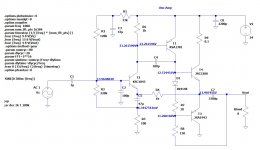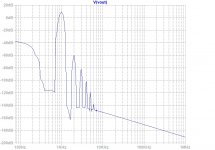Hello friends,
Today I tested an extremely simple project (4 transistors) developed and produced by a friend of mine from Brazil.
His website is this: AlfaKits Eletrônica
The cool thing is that on his site is shared free of charge the electrical scheme and layout of the PCB for those who want to produce for their own use. Production for sale is prohibited.
I was impressed by the level of THD he achieved with a simple 12 to 15V power supply and only 4 transistors.
Check out the results:
I couldn't post the photos. Following is the link to the results:
RB Eletronica - UNO
I'll publish on my YT channel the details about that test, soon.
YouTube
Today I tested an extremely simple project (4 transistors) developed and produced by a friend of mine from Brazil.
His website is this: AlfaKits Eletrônica
The cool thing is that on his site is shared free of charge the electrical scheme and layout of the PCB for those who want to produce for their own use. Production for sale is prohibited.
I was impressed by the level of THD he achieved with a simple 12 to 15V power supply and only 4 transistors.
Check out the results:
I couldn't post the photos. Following is the link to the results:
RB Eletronica - UNO
I'll publish on my YT channel the details about that test, soon.
YouTube
Last edited:
Gratulation.
One of the best complementary-transistors-pp-design you can do. And listen.
Nearly no grainy too;-)
Have fun!
...and do not switch to a fat complementary-transes-pp-power amp;-!!!!
One of the best complementary-transistors-pp-design you can do. And listen.
Nearly no grainy too;-)
Have fun!
...and do not switch to a fat complementary-transes-pp-power amp;-!!!!
I can't open the images. Have good luck selling those kits. Interesting for students.
Saludos de Argentina.
Saludos de Argentina.
No emitter resistors, and a single diode as a base spreader as a consequence, to limit the risk of thermal runaway is a good recipe for Xover distortion.
It may give more "edge" to loud music, but for softer programs it could be somewhat unpleasant.
In addition, the speaker will see a permanent 30~40mA DC current.
Not catastrophic for a big 100W or so unit, but not ideal for a 5 or 10W one
It may give more "edge" to loud music, but for softer programs it could be somewhat unpleasant.
In addition, the speaker will see a permanent 30~40mA DC current.
Not catastrophic for a big 100W or so unit, but not ideal for a 5 or 10W one
The already given answer;-?
Today I tested ...
I was impressed by the level of THD he achieved with a simple 12 to 15V power supply and only 4 transistors.
I also had a ZX spectrum, and IIRC the OP stage was even cruder, something like a single, binary-controlled transistor.
The THD figure of the 4-transistor amp might be relatively low (hard data please?), but Xover distortion does generally not have a large impact on the global THD figure, it is simply extremely unpleasant, even at very low numerical levels.
An oscilloscope or an ear is a better detection tool than a THD meter in this case
The THD figure of the 4-transistor amp might be relatively low (hard data please?), but Xover distortion does generally not have a large impact on the global THD figure, it is simply extremely unpleasant, even at very low numerical levels.
An oscilloscope or an ear is a better detection tool than a THD meter in this case
An oscilloscope or an ear is a better detection tool than a THD meter in this case
The ear does say: Yeah;-)
... clean sounding sources and speakers are necessary;-!
I ran a quick simulation using commonly available actives for the typical roles here.
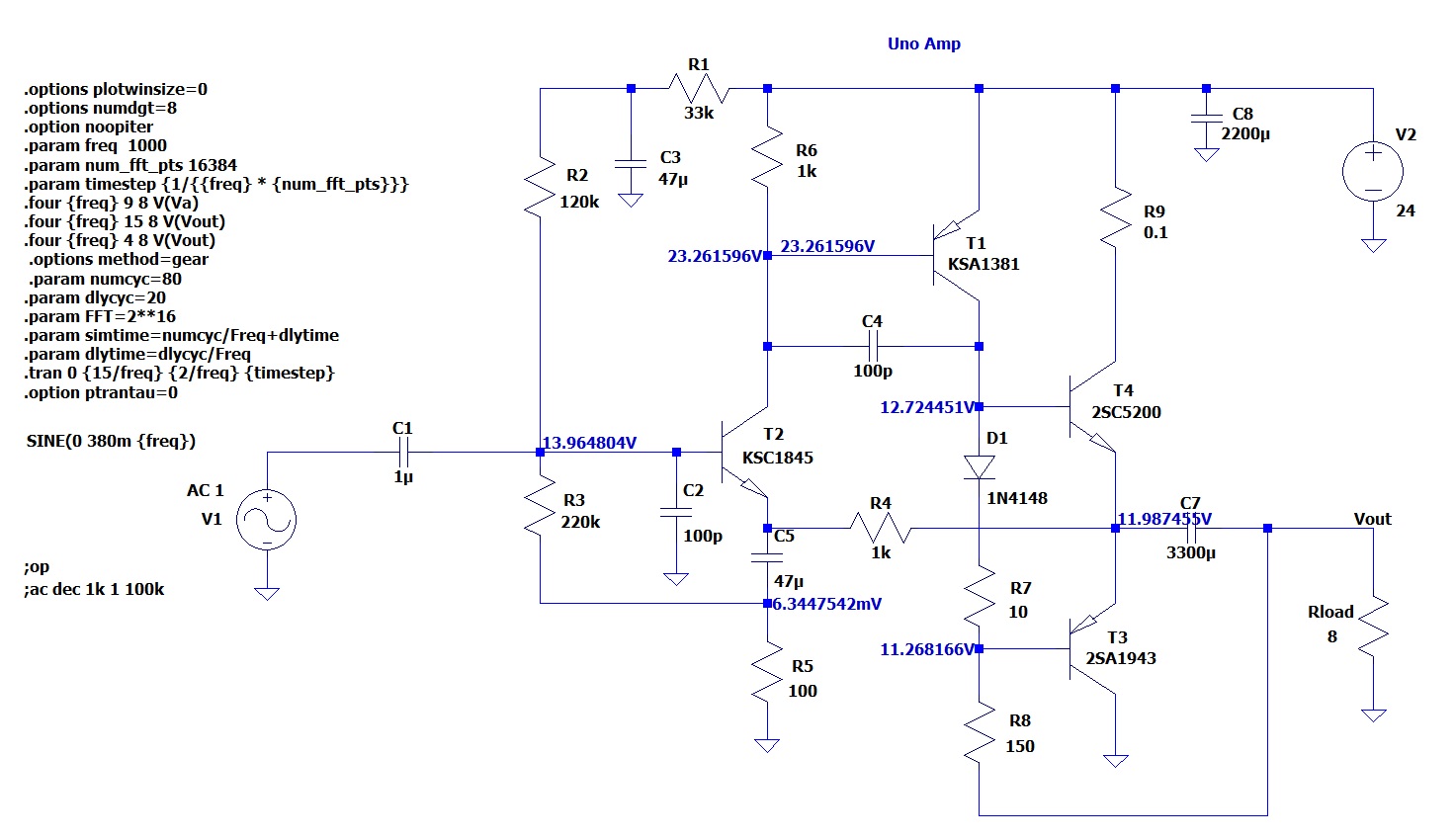
Increased the operating voltage to 24v and got this:
For 8Vpp (2.83vrms) into 8ohms for 1w:
It has 2nd order dominant distortion with a monotonically decreasing profile. So should sound good. I do not see it as particularly low THD though, but that is to be expected of a 4-active singleton amp:
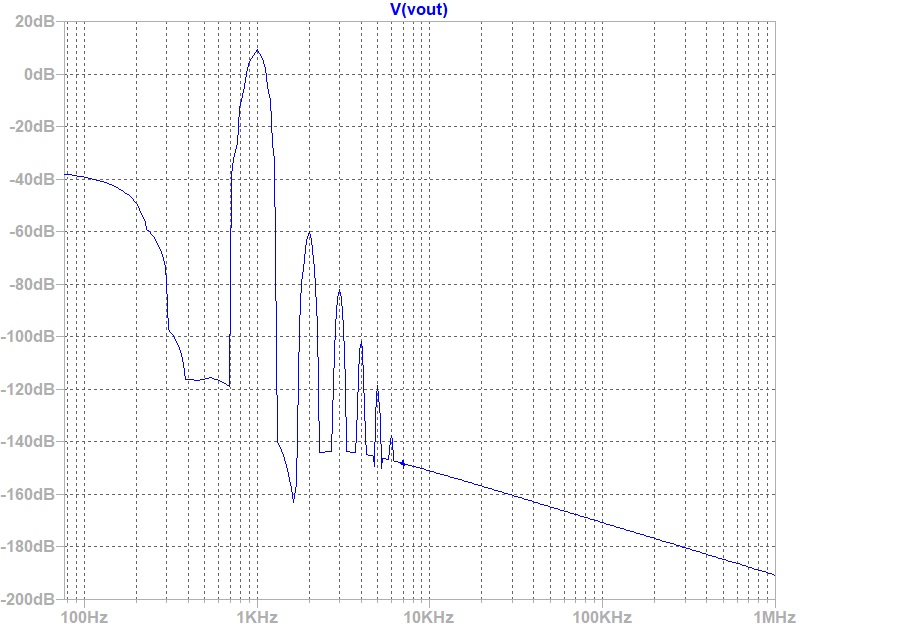
Increased the operating voltage to 24v and got this:
For 8Vpp (2.83vrms) into 8ohms for 1w:
Code:
Harmonic Frequency Fourier Normalized Phase Normalized
Number [Hz] Component Component [degree] Phase [deg]
1 1.000e+03 4.087e+00 1.000e+00 2.16° 0.00°
2 2.000e+03 1.525e-03 3.732e-04 113.93° 111.77°
3 3.000e+03 2.855e-04 6.987e-05 178.73° 176.57°
4 4.000e+03 2.991e-04 7.319e-05 178.34° 176.19°
5 5.000e+03 2.397e-04 5.866e-05 -179.55° -181.70°
6 6.000e+03 1.984e-04 4.855e-05 -179.62° -181.77°
7 7.000e+03 1.701e-04 4.162e-05 -179.72° -181.88°
8 8.000e+03 1.488e-04 3.642e-05 -179.75° -181.91°
9 9.000e+03 1.323e-04 3.237e-05 -179.78° -181.94°
10 1.000e+04 1.191e-04 2.914e-05 -179.80° -181.96°
11 1.100e+04 1.083e-04 2.649e-05 -179.82° -181.98°
12 1.200e+04 9.923e-05 2.428e-05 -179.84° -181.99°
13 1.300e+04 9.160e-05 2.241e-05 -179.85° -182.00°
14 1.400e+04 8.505e-05 2.081e-05 -179.86° -182.01°
15 1.500e+04 7.938e-05 1.942e-05 -179.87° -182.02°
Total Harmonic Distortion: 0.040360%(0.292814%)It has 2nd order dominant distortion with a monotonically decreasing profile. So should sound good. I do not see it as particularly low THD though, but that is to be expected of a 4-active singleton amp:
Attachments
Last edited:
It is able to make 7w into 8ohms with fairly low distortion:
I should add that this is a fairly high bias current of 640mA (sort of Class A) and dissipating about 8w per output active.
Code:
Harmonic Frequency Fourier Normalized Phase Normalized
Number [Hz] Component Component [degree] Phase [deg]
1 1.000e+03 1.075e+01 1.000e+00 2.16° 0.00°
2 2.000e+03 9.502e-03 8.841e-04 100.52° 98.37°
3 3.000e+03 2.996e-03 2.788e-04 7.43° 5.27°
4 4.000e+03 1.224e-03 1.139e-04 -122.71° -124.87°
5 5.000e+03 2.125e-03 1.977e-04 -173.41° -175.57°
6 6.000e+03 1.677e-03 1.560e-04 118.78° 116.62°
7 7.000e+03 9.150e-04 8.514e-05 18.63° 16.48°
8 8.000e+03 1.325e-03 1.233e-04 -92.76° -94.91°
9 9.000e+03 1.647e-03 1.532e-04 -167.37° -169.53°
10 1.000e+04 1.374e-03 1.278e-04 120.45° 118.30°
11 1.100e+04 9.276e-04 8.632e-05 25.36° 23.20°
12 1.200e+04 1.068e-03 9.935e-05 -82.19° -84.34°
13 1.300e+04 1.302e-03 1.212e-04 -161.21° -163.36°
14 1.400e+04 1.126e-03 1.048e-04 125.30° 123.14°
15 1.500e+04 7.646e-04 7.114e-05 33.56° 31.40°
Total Harmonic Distortion: 0.102280%(0.309343%)I should add that this is a fairly high bias current of 640mA (sort of Class A) and dissipating about 8w per output active.
Amps like that were abundant in 70's, 80's. I've built shitloads of small amps with above topology back then. The ones with germ. outputs (a popular pair was AD161/162) were particularly "good" sounding (had a really good presentation of new-vawe and punk guitars - which used to be popular then). Another popular Si pair for car-radios was BD433/434.
If made with a darlington input (or a bit more heavily bootstrapped than above amp); it can be fed directly from a ceramic cartridge record player (audiophiles beware!)
If made with a darlington input (or a bit more heavily bootstrapped than above amp); it can be fed directly from a ceramic cartridge record player (audiophiles beware!)
Yes, but JLH did not have push pull output.
One thing I noticed with this amp that is unique: despite having output coupling cap, there is a slight 500mV DC offset due to the connection from the base of the PNP to the output after the cap.
This offset is not a good thing as voice coil will heat up a bit.
One thing I noticed with this amp that is unique: despite having output coupling cap, there is a slight 500mV DC offset due to the connection from the base of the PNP to the output after the cap.
This offset is not a good thing as voice coil will heat up a bit.
The originals were generally much better than this example: here is a large collection from various sources:Amps like that were abundant in 70's, 80's.
A collection of vintage, single supply, low to medium power amplifiers for Daniel
This one from a Motorola appnote probably served as a model:
I have also described a number of evolutions based on the same theme, and they really bring novel features and good performance.
Otherwise, stick with the good old original circuits: they are still current and usable, unlike some pale copies
The originals were generally much better than this example: here is a large collection from various sources:
A collection of vintage, single supply, low to medium power amplifiers for Daniel
It's almost the same topology.
This is a very cool material!
Amps like this are fun to make. You can even do it on veroboard or P2P. They certainly sound nice.
I ran a quick simulation using commonly available actives for the typical roles here.
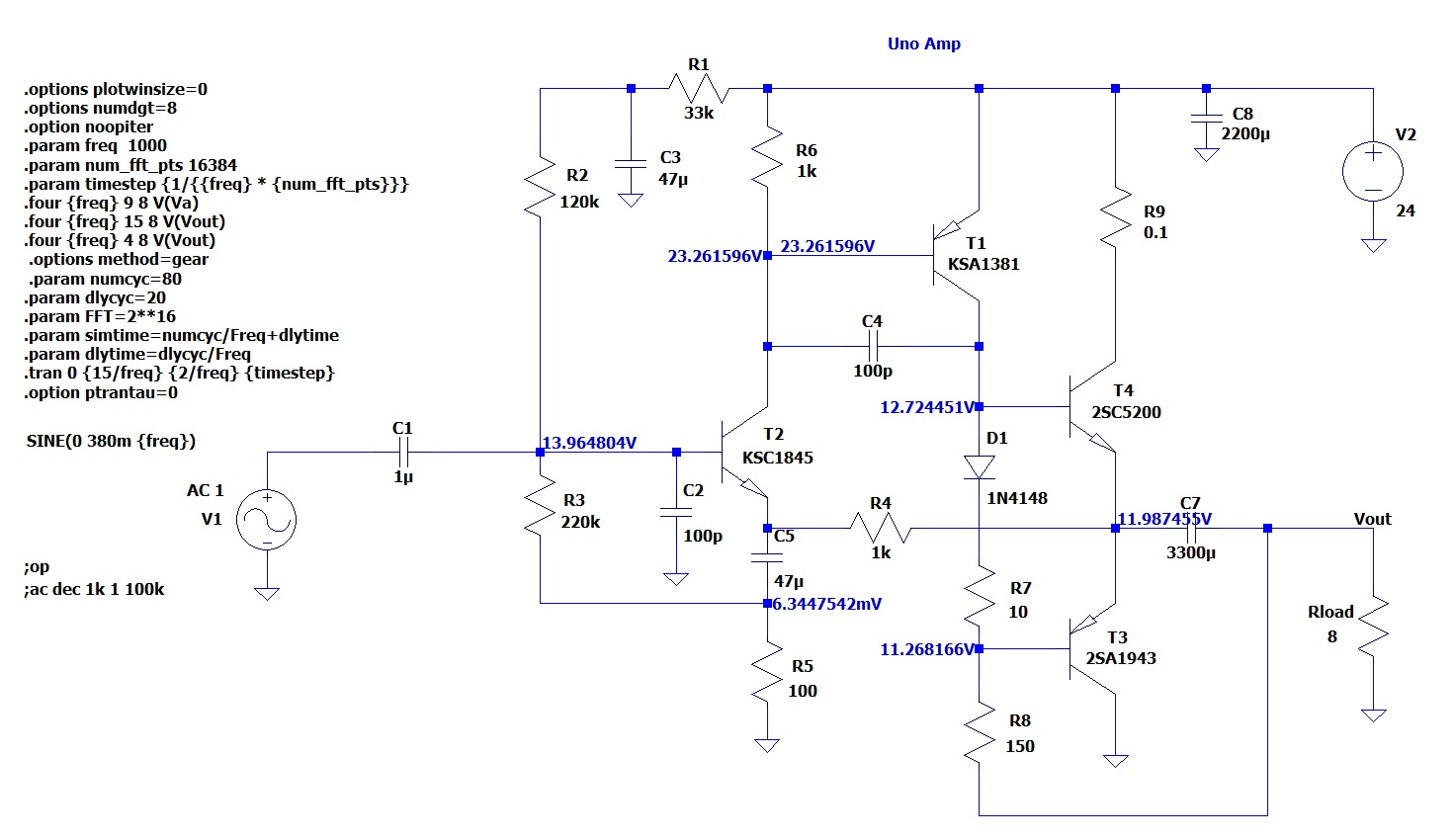
Increased the operating voltage to 24v and got this:
For 8Vpp (2.83vrms) into 8ohms for 1w:
Code:Harmonic Frequency Fourier Normalized Phase Normalized Number [Hz] Component Component [degree] Phase [deg] 1 1.000e+03 4.087e+00 1.000e+00 2.16° 0.00° 2 2.000e+03 1.525e-03 3.732e-04 113.93° 111.77° 3 3.000e+03 2.855e-04 6.987e-05 178.73° 176.57° 4 4.000e+03 2.991e-04 7.319e-05 178.34° 176.19° 5 5.000e+03 2.397e-04 5.866e-05 -179.55° -181.70° 6 6.000e+03 1.984e-04 4.855e-05 -179.62° -181.77° 7 7.000e+03 1.701e-04 4.162e-05 -179.72° -181.88° 8 8.000e+03 1.488e-04 3.642e-05 -179.75° -181.91° 9 9.000e+03 1.323e-04 3.237e-05 -179.78° -181.94° 10 1.000e+04 1.191e-04 2.914e-05 -179.80° -181.96° 11 1.100e+04 1.083e-04 2.649e-05 -179.82° -181.98° 12 1.200e+04 9.923e-05 2.428e-05 -179.84° -181.99° 13 1.300e+04 9.160e-05 2.241e-05 -179.85° -182.00° 14 1.400e+04 8.505e-05 2.081e-05 -179.86° -182.01° 15 1.500e+04 7.938e-05 1.942e-05 -179.87° -182.02° Total Harmonic Distortion: 0.040360%(0.292814%)
It has 2nd order dominant distortion with a monotonically decreasing profile. So should sound good. I do not see it as particularly low THD though, but that is to be expected of a 4-active singleton amp:

What about AC analysis ??
- Home
- Amplifiers
- Solid State
- Extremely simple amplifier (4 transistors) with low THD.

